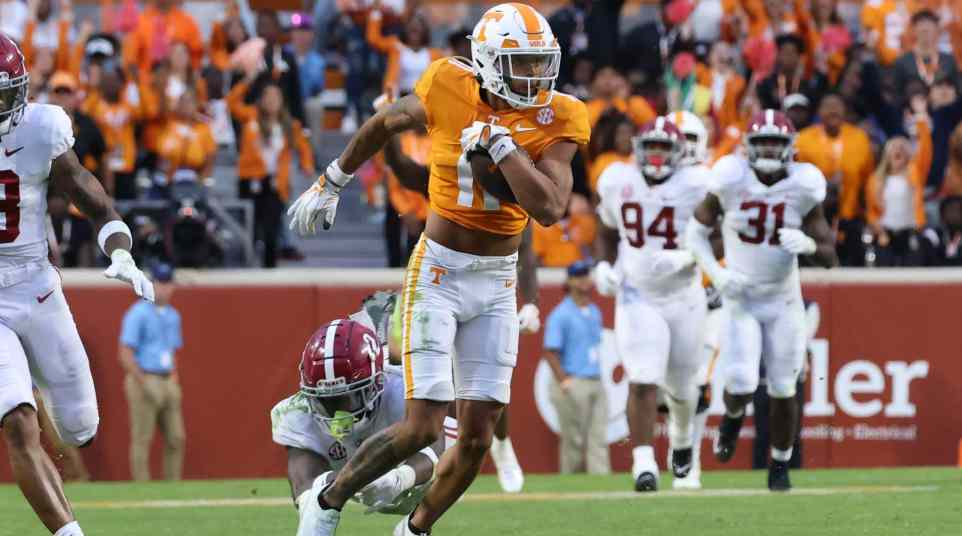
Hayes: NFL scouts reveal how Alabama can fix its struggling defense
Of all the numbers and all the damage the Tennessee offense inflicted on Alabama last weekend, none was more telling than 3 foundational statistics.
The Vols averaged 8.1 yards per play, 4.7 yards per carry and — the knockout punch — 12.4 yards per pass attempt from QB Hendon Hooker.
And one more, in case the body is still moving: 18.3 yards per completion.
“I’ve never seen an Alabama pass rush and secondary so out of sync, so out of its element,” an NFL scout told me.
The obvious question: How do you fix it?
How do Alabama coach Nick Saban — one of the greatest defensive minds in football history — and defensive coordinator Pete Golding keep that defense from collapsing within?
It’s not as difficult as you’d think — at least, according to 3 NFL scouts I spoke to this week.
“The initial response is overreaction, because that’s always the reaction on the outside,” an NFL scout told me. “I can guarantee Nick isn’t overreacting. He’s working the problem.”
The breakdowns against Tennessee revolve around two key areas: an inability to affect the quarterback, and coverage breakdowns in the secondary.
Vols coach Josh Heupel made a decision before the game to run on every 2nd down. He didn’t want Tennessee facing 3rd-and-make-a-play after an incomplete pass on 2nd down — because an incomplete pass could give Alabama time to get fresh legs on the field in pass rush, and make a more informed play call.
Heupel wanted blazing-fast tempo, and at one point early in the game, the Vols averaged nearly 4 plays a minute. The tempo and the efficiency in both the run and pass games rendered star Tide rush ends Will Anderson and Dallas Turner ineffective.
Anderson, the best defensive player in college football, had 3 tackles and half a tackle for loss. Turner had 2 tackles. Neither had a sack or quarterback hurry.
All but 1 Tennessee touchdown was a 1st or 2nd-down play.
“First, you have to be extremely efficient to run every 2nd play,” another NFL scout said. “Because the defense will quickly adjust. (Tennessee) ran the ball so well, and was so committed to that plan no matter the result on 2nd down, that it rarely put the offense in difficult down and distance — no matter how the defense adjusted. Are there teams Alabama will play down the road that can be that efficient on offense? Doubtful. But there could be a team or 2 that will stress them.”
Alabama has had problems in the back end for much of the season. LSU transfer Eli Ricks, a freshman All-American, was expected to win 1 of the 2 starting cornerbacks spots. He hurt his back in fall camp, and Saban hinted last month that he hasn’t practiced well.
That has left Alabama with Kool-Aid McKinstry, its most consistent corner, and Terrion Arnold, Malachi Moore and Brian Branch rotating in coverage at the other corner and nickel back. None played well against Tennessee.
“A lot of it was technique and leverage,” another NFL scout told me. “All of those (cornerbacks), including McKinstry, who is their best guy, are really sloppy with technique. If you’re playing a team that precise in its routes and how it delivers the ball, you can’t be sloppy. It’s simple adjustments, like turning your head and locating balls instead of turning your shoulders and head and opening your body to locate balls.
“They need help from the guys over the top, too. At some point, after (Tennessee WR Jalin Hyatt) caught his 3rd touchdown pass, if you’re a safety, you’ve got to start anticipating. That’s ball skills, and understanding where you are on the field. Again, that’s teachable.”
The problems in the secondary were compounded by Alabama’s inability to affect the quarterback with Anderson, Turner and DE Bryon Young. The tempo of the game — combined with the Tennessee receivers winning on the outside for quick timing throws, and Hooker’s ability to move in the pocket and go off schedule and throw with accuracy — was, according to one scout, “the perfect storm.”
“We’ve been in those situations,” the scout said. “It’s a helpless feeling. Nothing you do can change what’s going on. In that situation, you’ve got to hope your guys can cover better. That’s the only out. And that back end was so shellshocked, they didn’t know what hit them from the first drive.”
When asked which teams on the remainder of the schedule could pose problems for the Alabama defense, all 3 scouts said Ole Miss.
“Because they can run the ball to set up those deep throws,” the scout said. “The quarterback (Jaxson Dart) can also run, and that stresses your linebackers and forces you to account for him. Now (Dart) isn’t as accurate as Hooker, but he’ll make enough throws to put your defense on its heels.”
When asked if Georgia will pose a threat if it reaches the SEC Championship Game, all 3 scouts said not nearly as big a problem as Tennessee.
“Georgia? Georgia has to beat Tennessee to get a shot at Alabama,” a scout said. “I’m not sure that happens.”
Said another: “Georgia’s receivers do nothing for me right now. Nothing special. The tight end (Brock Bowers) is terrific. But the difference between Georgia’s receivers and Tennessee’s is night and day. And the quarterback (Stetson Bennett) isn’t as efficient and dangerous as (Hooker).”
